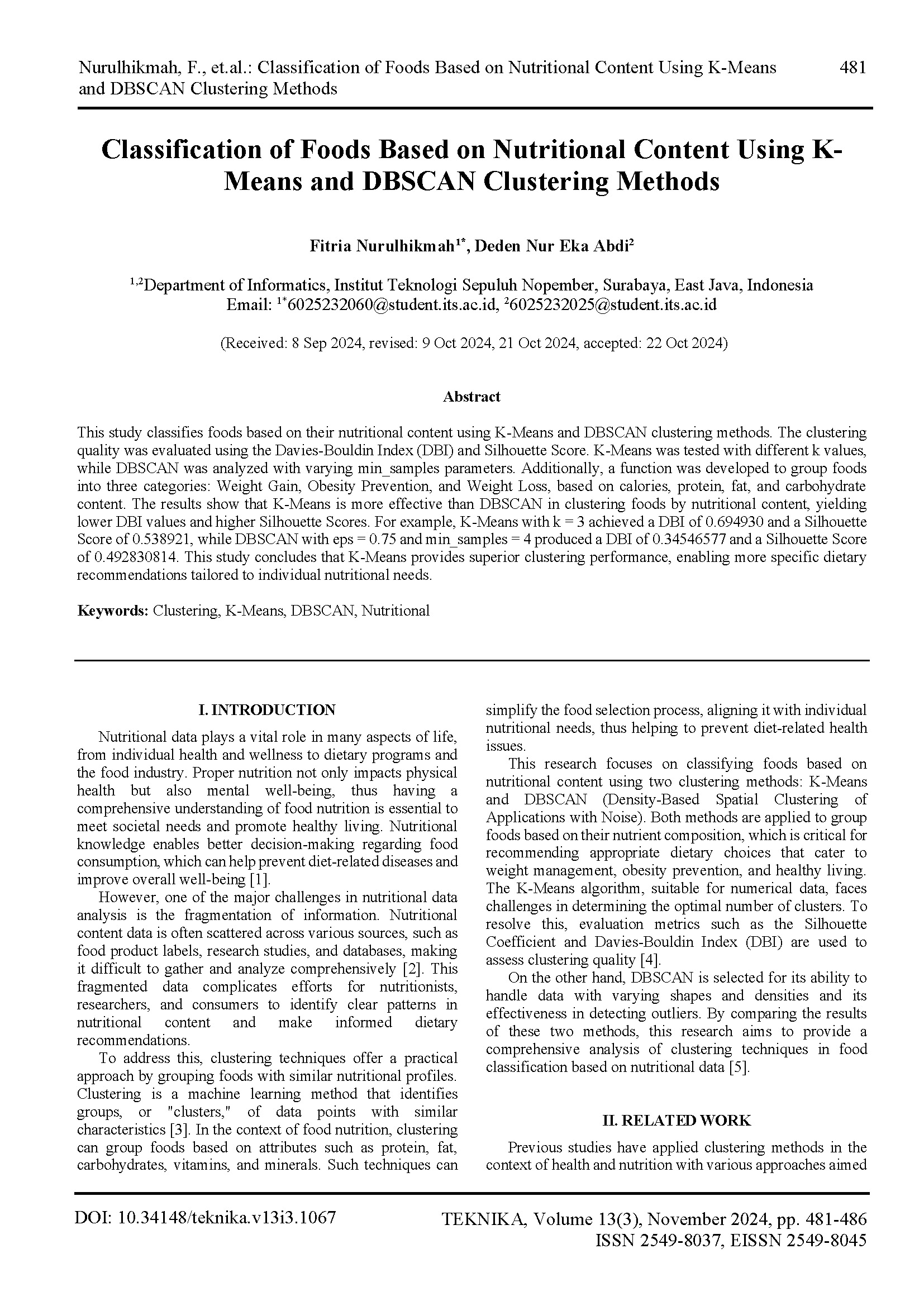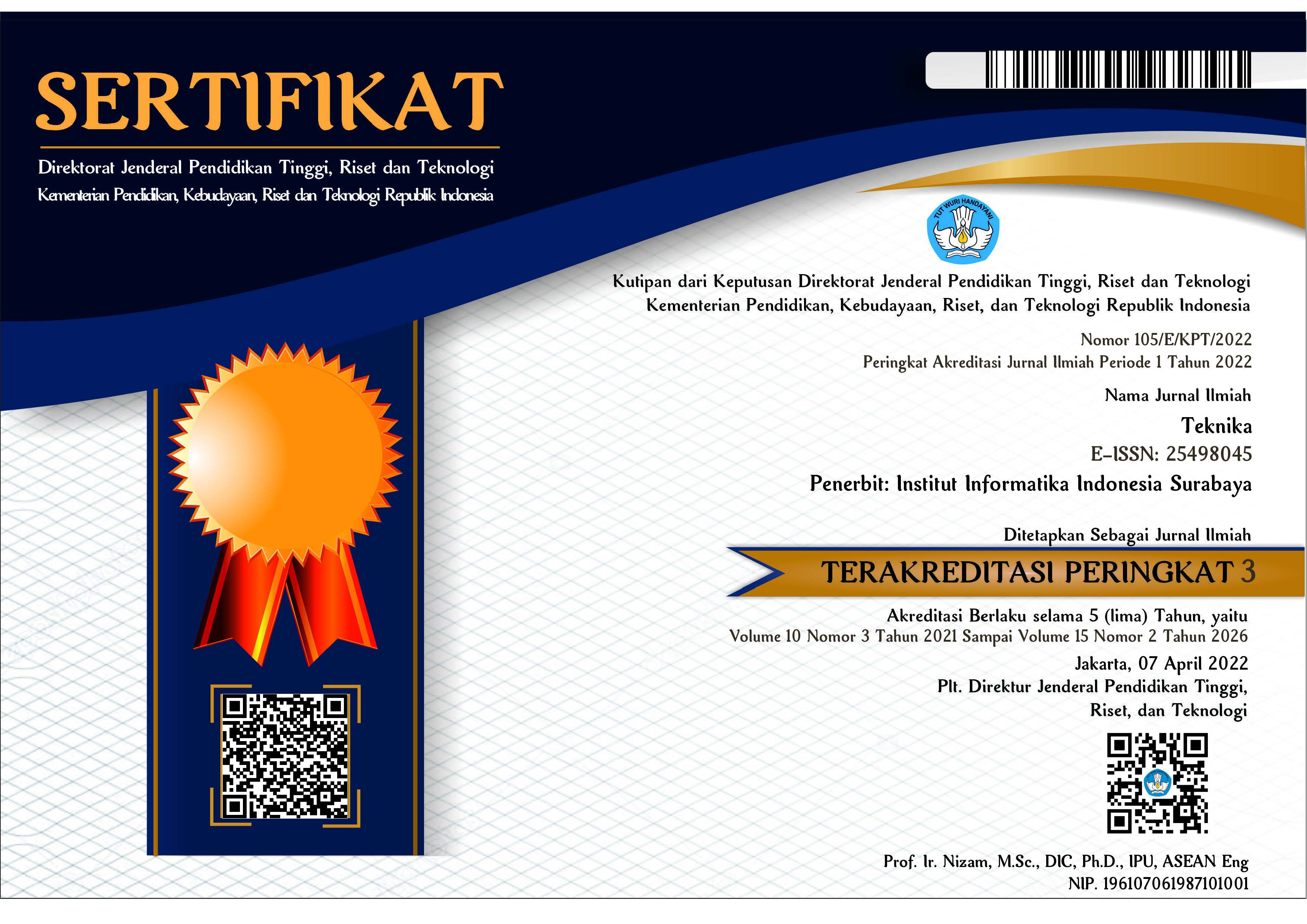Classification of Foods Based on Nutritional Content Using K-Means and DBSCAN Clustering Methods
DOI:
https://doi.org/10.34148/teknika.v13i3.1067Keywords:
Clustering, K-Means, DBSCAN, NutritionalAbstract
This study classifies foods based on their nutritional content using K-Means and DBSCAN clustering methods. The clustering quality was evaluated using the Davies-Bouldin Index (DBI) and Silhouette Score. K-Means was tested with different k values, while DBSCAN was analyzed with varying min_samples parameters. Additionally, a function was developed to group foods into three categories: Weight Gain, Obesity Prevention, and Weight Loss, based on calories, protein, fat, and carbohydrate content. The results show that K-Means is more effective than DBSCAN in clustering foods by nutritional content, yielding lower DBI values and higher Silhouette Scores. For example, K-Means with k = 3 achieved a DBI of 0.694930 and a Silhouette Score of 0.538921, while DBSCAN with eps = 0.75 and min_samples = 4 produced a DBI of 0.34546577 and a Silhouette Score of 0.492830814. This study concludes that K-Means provides superior clustering performance, enabling more specific dietary recommendations tailored to individual nutritional needs.
Downloads
References
Lin, Q. (2021). Equity-ecological food system based on hierarchical clustering. 2021 IEEE Conference on Telecommunications, Optics and Computer Science (TOCS).
Hargreaves, D., Mates, E., Menon, P., Alderman, H., Devakumar, D., Fawzi, W., Greenfield, G., Hammoudeh, W., He, S., Lahiri, A., Liu, Z., Nguyen, P. H., Sethi, V., Wang, H., Neufeld, L. M., & Patton, G. C. (2022). Strategies and interventions for healthy adolescent growth, nutrition, and development. The Lancet, 399(10320), 198–210.
D. Deng, “Research on Anomaly Detection Method Based on DBSCAN Clustering Algorithm,” in Proceedings - 2020 5th International Conference on Information Science, Computer Technology and Transportation, ISCTT 2020, Institute of Electrical and Electronics Engineers Inc., Nov. 2020, pp. 439– 442. doi: 10.1109/ISCTT51595.2020.00083.
Vredizon, P. A., Firmansyah, H., Salsabila, N. S., & Nugroho, W. E. (2024). Penerapan algoritma K-Means untuk mengelompokkan makanan berdasarkan nilai nutrisi. Journal of Technology and Informatics (JoTI), 5(2), April.
Z. Zhou, L. Luo, Z. Li, M. Chao, W. Tang, and Y. Wang, “Harmonic pollution zoning method based on improved DBSCAN clustering,” in China International Conference on Electricity Distribution, CICED, IEEE Computer Society, 2022, pp. 1099–1103. doi:
I. W. Septiani, Abd. C. Fauzan, Dan M. M. Huda, “Implementasi Algoritma K-Medoids Dengan Evaluasi Davies-Bouldin-Index Untuk Klasterisasi Harapan Hidup Pasca Operasi Pada Pasien Penderita Kanker ParuParu,” Jurnal Sistem Komputer Dan Informatika (Json), Vol. 3, No. 4, Hlm. 556, Jul 2022, Doi: 10.30865/Json.V3i4.4055
Muhammad Sholeh, Dina Andayati, Rr. Yuliana Rachmawati. (2022). "Data Mining Model Klasifikasi Menggunakan Algoritma K-Nearest Neighbor dengan Normalisasi untuk Prediksi Penyakit Diabetes." Jurnal TeIKa, Volume 12, Nomor 2, Oktober 2022.
A. Ambarwari, Q. Jafar Adrian, dan Y. Herdiyeni. (2020). "Analysis Of The Effect Of Data Scaling On The Performance Of The Machine Learning Algorithm For Plant Identification." Jurnal RESTI (Rekayasa Sistem dan Teknologi Informasi), Vol. 4(No. 1), hlm. 117-122. DOI: 10.29207/resti.v4i1.1517.
Hadikurniawati, W., Hartomo, K. D., & Sembiring, I. (2023). Spatial clustering of child malnutrition in Central Java: A comparative analysis using K-Means and DBSCAN. Proceedings of the 2023 International Conference on Modeling & E-Information Research, Artificial Learning and Digital Applications (ICMERALDA).
Rimelda Adha, Nana Nurhaliza, Ummi Soleha, Mustakim. (2021). Perbandingan Algoritma DBSCAN dan K-Means Clustering untuk Pengelompokan Kasus Covid-19 di Dunia. Jurnal Sains, Teknologi dan Industri, Vol. 18(No. 2), 206-211. ISSN 1693-2390 (print)/ISSN 2407-0939 (online).
Rahmawati, & Faisal, M. (2019). Analisis Cluster untuk Pengelompokan Desa Berdasarkan Indikator Penyakit Diare. Saintifik, Vol. 5(No. 1), 75-80.
Harjanto, T. D., Vatresia, A., & Faurina, R. (2021). Analisis penetapan skala prioritas penanganan balita stunting menggunakan metode DBSCAN clustering. Jurnal Rekursif, 9(1), 1-XX. ISSN 2303-0755.























